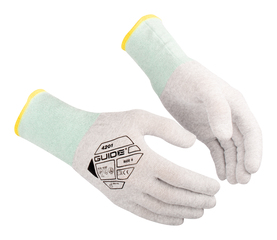
Protection against static electricity
A small spark that causes big problems
Electrostatic discharges that constantly occur naturally around us are usually so low in voltage that you can neither see them, nor get hurt by them. However, for circuit boards, hard drives, and other electric components, this poses a real danger that can lead to extensive costs and even safety risks. For the development of our next ESD range, we took a deep interest in the issues and reality that end users face.
In some cases, electrostatic discharges cause the component to stop working immediately, so-called instant deaths. But instant death is only the outcome for between 10 and 20 percent of all damages caused by electrostatic discharges. Instead, latent damage accounts for most of all cases. Latent damages may pass tests but can impair the components performance to the point that, more or less, serious breakdowns occur later.
This little spark is therefore a real problem for manufacturers of electrical components. For example, a third of all quality incidents in cars are caused by faulty electronic equipment: half of them come from upstream manufacturing issues, the other half can be avoided by paying more attention to the risks of electrostatic discharges1.
Indeed, damages caused to circuit boards, hard drives and other components hence causes quality problems for the final product, but also high costs for manufacturers. Although many manufacturers are already aware of the problem and are trying to work in static dissipative environments to some extent, unexpected discharges are still occurring due to damaged or inadequate protective equipment, such the working gloves.
However, working with small components requires a lot of dexterity, but also sensitivity. The major challenge in avoiding electrostatic discharges is therefore to find an effective solution which at the same time considers the precision necessary to work with small components. Otherwise, there is a risk workers chose to do their work with their bare hands.
This situation has led us to work hard to develop a new type of static dissipating gloves where the usual filaments are replaced by extra fine and highly conductive filaments, made of nanoparticles or carbon fibers for more reliable and effective protection all over the hand.
At the same time, the dexterity and sensitivity required to work with small components has also been the focus: the gloves are made of ultra-light liners - knitted in 15 or 18 gauge and mixed with a high percentage of spandex - dipped on 3D preformed shapes. This unique combination offers both optimal mechanical protection and fully respects the complexity of hand movement.
See all our new gloves that protects against electrostatic discharges
You can read more about our ESD-gloves here. Or contact us for any inquiries regarding our gloves.
We guide you to the right gloves - Contact us!
Did you know you can book an audit from Guide Gloves, free of charge, where we review your needs based on your specific conditions and challenges? Book an audit here.



.jpeg)



